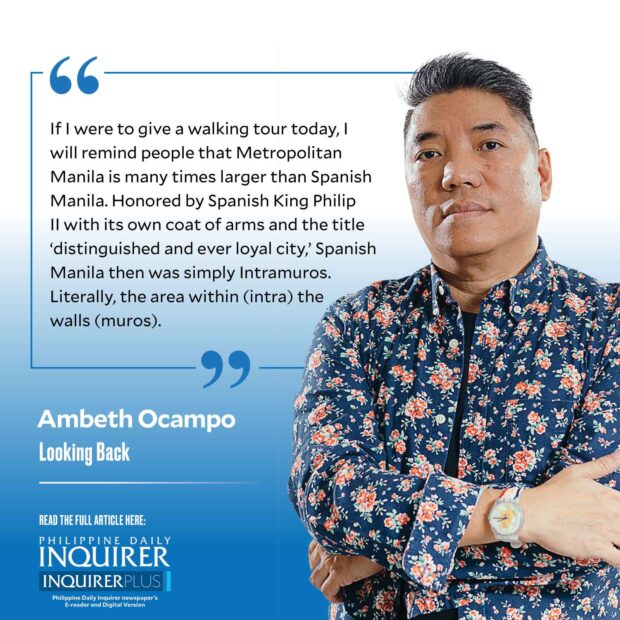Talking and walking history
 Many people I know can’t believe I take the point-to-point (P2P) bus from Ayala One to the Ateneo, instead of being in the chauffeur-driven, air-conditioned comfort of a Grab or private car.
Many people I know can’t believe I take the point-to-point (P2P) bus from Ayala One to the Ateneo, instead of being in the chauffeur-driven, air-conditioned comfort of a Grab or private car.
The first P2P buses I took, as a sixth-grader in 1975, went from Cubao Alimall to Escolta to Rustan’s Makati. Imelda Marcos christened these air-conditioned buses, with brightly painted hearts, as the “Love Bus.” For a P2.50 flat rate, it was a safe, comfortable way to get around Metro Manila. Today, the Ayala-UP Town Center P2P fare costs P100 or P80 for seniors and PWD. Like its martial law predecessor, today’s P2P is a safe, comfortable way to travel. However, it does not run on weekends, and going from one shopping mall to another does not leave much room to explore more of the city as I did in my grade school days. The Escolta stop then was the beginning of many trips, on foot or on kalesa, around Binondo, Quiapo, Santa Cruz, Tondo, San Miguel, and the University Belt.
Long before Old Manila Walks operated by Ivan Man Dy was even a dream, I already had the Spanish-era “arrabales” or suburbs of Manila like the back of my hand. If I were to give a walking tour today, I will remind people that Metropolitan Manila is many times larger than Spanish Manila. Honored by Spanish King Philip II with its own coat of arms and the title “distinguished and ever loyal city,” Spanish Manila then was simply Intramuros. Literally, the area within (intra) the walls (muros).
It is ironic that the person who taught me a lot about old Manila was Pedro Ortiz Armengol, a writer and historian who served as Spanish ambassador to the Philippines during the tense days of Edsa 1986. One Saturday morning, we walked around Binondo with an 1872 map of Manila and a copy of Rizal’s “Noli me Tangere,” in the original Spanish of course. Our first stop was the present State Investment House Inc. building where the house of Balvino Mauricio once stood. This house whose interiors are captured in a painting by the 19th-century Filipino master Jose Honorato Lozano is believed to be the house Rizal used as a model for Kapitan Tiago’s house in the “Noli.” From here, we crossed a stinking polluted stream using the bridge in front of Binondo Church and turned left toward a fire station in search of the Fonda Fracesca de Lala Ary, also mentioned in the “Noli” as the hotel where Ibarra stayed. From Ibarra’s hotel room, he looked across the river into Kapitan Tiago’s house, the home of his sweetheart Maria Clara.
Using the “Noli,” we followed Ibarra as he walked from Kapitan Tiago’s house toward Binondo Church. He turned right onto what is now Ongpin street and walked toward a spot where he hailed a taxi that brought him back to the hotel. While the description in the 1887 novel does not correspond with 2023 Binondo, many of the sights, sounds, and smells remain. Ambassador Ortiz Armengol then said something that has remained with me since. Tracing out Ibarra’s route on the 1872 map with his index finger, he remarked, “The look or landscape of a city may change, but the outline of the city drawn by its streets, rivers, canals, and other topographical details remain.”
I have never looked at Metro Manila the same way since. Some years later, when I met with then retired ambassador Ortiz Armengol in Madrid, he gave me a tour of the sites in the novel of Benito Perez Galdos’ novel “Fortunata y Jacinta” published in Madrid in 1887. The same year the “Noli me Tangere” first saw print in Berlin.
I used the Ortiz Armegol method in curating a walking tour of Rizal’s Madrid for Filipinos who are willing to forgo half a day of shopping to trace the hero’s steps in the Spanish capital from the Palacio de Crystal in the Palacio del Buen Retiro all the way down to the famous Barrio de las Letras or Literary Quarter of Central Madrid. I have done the same for Rizal’s Hong Kong, Rizal’s Singapore, Rizal’s Tokyo, Rizal’s London, Rizal’s New York, Rizal’s Berlin, Rizal’s Heidelberg, and of course, Rizal’s Dapitan, Calamba, and Manila.
The late Teodoro Agoncillo once complained, and rightly so, that we are too focused on Rizal, with numerous requests for historical markers even in dark street corners where he relieved himself. Over the years, I have learned that it is not enough to read and talk about history, sometimes we have to walk history as well.
—————-
Comments are welcome at aocampo@ateneo.edu




















